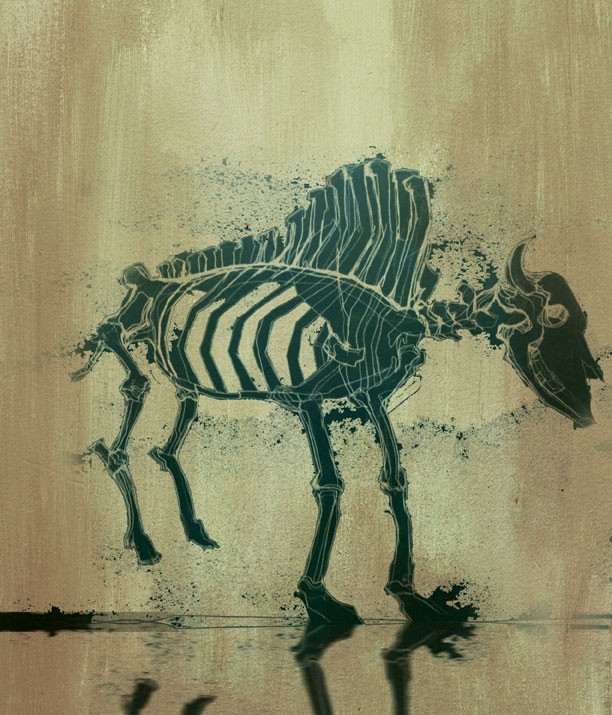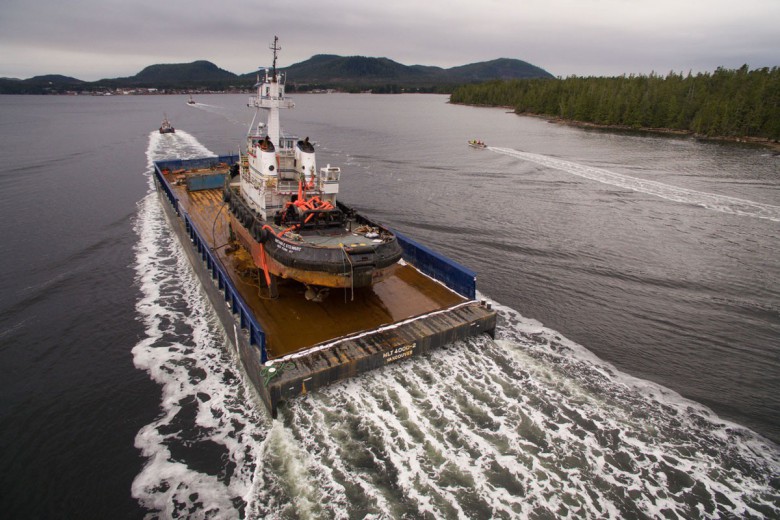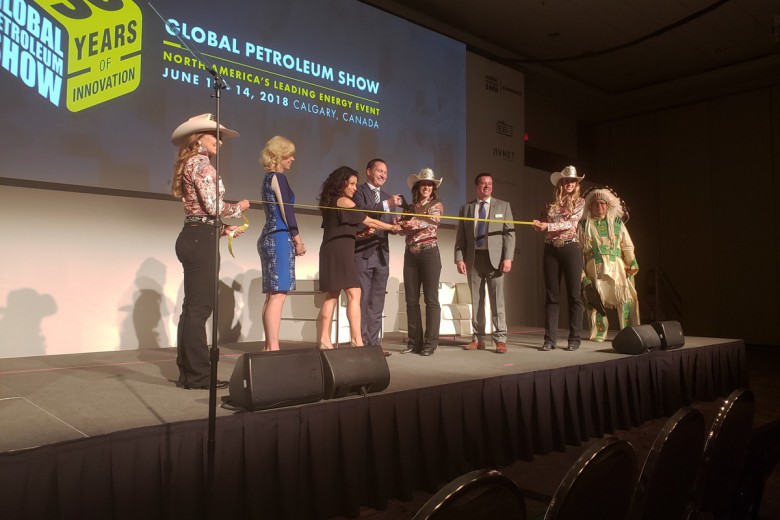I’m driving north from Fort McMurray; extraction sites dot the landscape, peeking through the thick forest surrounding the highway. Anna Tsing’s words come to mind: frontiers, like cancer and nuclear weapons, have a mode of expansion that is “always already out of control.” I pull over when the paved highway turns to dirt; trucks and buses full of workers pass by ceaselessly. This, in the midst of the summer of 2015 when fears about an oil downturn hover in the air.
Several days later, I fly to Fort Chipewyan, a community about 200 kilometres north of Fort Mac, located downstream on the southwestern tip of Lake Athabasca. A local resident, Alice Rigney, gives me her take on the motivation behind the perpetual oil expansion: “As long as there is oil, they will not stop because, to them, it’s black gold.” Later, I’m told the oil industry stretches a lot farther than the end of the paved highway: Teck Resources’ “Frontier project” is 110 kilometres south of Fort Chip.
Fort Chip is a predominantly Indigenous community, home to over 1,200 Cree, Métis, and Chipewyan or Dene people. The fresh air reminds me of how polluted city life is. Still, community members here often wake up to sulphur-permeated winds.
I am invited by Mikisew Cree First Nation locals to attend a government and industry relations cultural retreat taking place near Doré Lake. Before we eat a large “free” meal, cooked with ingredients flown into the community, oil industry representatives pass out small paper bags of fruit to the Elders. An Elder sitting next to me laughs and jokingly says, “This will last the whole year … I thought these bags were going to be full of money.”
I leave the retreat to meet Rigney, an Elder who describes herself as “a proud Dene woman who lives off the land as much as she can and will fight to the bitter end for her grandchildren and great-grandchildren.” As her grandchildren and dogs run around a yard brimming with plant life, Rigney recounts how the water began to change in the 1960s, when BC Hydro’s W.A.C. Bennett Dam was constructed. In the years that followed, she witnessed the installation of the oil industry and its attendant harms: violence, toxicity, displacement, and cancer. Now, a swimming pool is being built for children forbidden from swimming in the lake. As a cancer survivor, Rigney knows all too well the effects of the oil industry’s rampant expansion.
The flow of unconventional oil
In December of 2002, Marilyn Radler published an article in the Oil & Gas Journal announcing that Alberta’s tarsands are recoverable reserves, meaning that they house oil that can be extracted from the Earth. The article signalled a global shift toward “unconventional” modes of extraction, exemplified by the Alberta tarsands. By the mid-2000s, the global peak of crude oil, technological advancements, increased xenophobia post-9/11, and a rise in global oil prices sparked a boom in Alberta’s “unconventional” oil.
Unconventional oil, an industry category, refers to a heavy type of oil that is deep in the earth, tightly sandwiched between or bound to sand, tar, and rock. It includes oil shale and heavy oil, as well as tarsands oil, although the Alberta Energy Regulator does not recognize the latter as “unconventional.” These resources are typically classified this way because they require more extreme extraction techniques than crude oil. Unconventional oil’s counterpart, unconventional gas, also employs extreme methods: fracking, for instance, has been linked to earthquakes.
The unconventional oil of Alberta is extracted in two ways: open-pit mining and in situ drilling. Only 18 per cent of Alberta’s tarsands are shallow enough to mine from the surface. The rest are accessed using in situ techniques. Steam-assisted gravity drainage (SAGD), the more common method of in situ extraction in Alberta, is a process of injecting steam deep into the earth in order to reduce the viscosity of the bitumen, allowing it to be pumped out for processing. By 2012, in situ production surpassed open-pit mining.
The fracking of liquefied natural gas from First Nations’ unceded territories in B.C. produces the liquefied natural gas that is subsequently used for in situ drilling projects. Tarsands processing occurs near the Aamjiwnaang community in Sarnia, Ontario. Kilometres of rail lines and pipelines transport oil across treaty territory. The oil industry is only able to exist through neocolonial land grabs and occupation.
Resisting contamination
In 2010, the first of five annual Tar Sands Healing Walks in Fort McMurray took place. It was both a protest of the oil industry and an opportunity to pray for the land’s regeneration. The decision to halt the Healing Walks in Fort McMurray was made in order to build resistance in other affected communities, explains Jesse Cardinal, coordinator with Keepers of the Athabasca. “The cumulative effects of open-pit mining and in situ mining are just devastating to the land. It is really covering all of northeastern Alberta; there is the Conklin area, the Cold Lake deposit and the Peace River. That’s covering a lot of land and a lot of communities.”
The Fort McMurray mines have received attention in part because open-pit mines have visible tailings ponds, Cardinal says. From her perspective, in situ projects have proliferated without much protest or attention because the industry has framed them “as an environmentally friendly way of extracting bitumen out of the ground.” Both the industry and government claim that up to 90 per cent of the water used in SAGD is recycled. But these recycle rates only consider freshwater use, leaving saline groundwater use largely unmonitored, and overlooking groundwater and surface water dynamics.
The extensive greenwashing of in situ projects has resulted in what Cardinal says is “pretty much 99 per cent approvals on in situ mining applications. There are definitely groups and organizations that are hugely concerned about it, but the approval process is set up in a way that they have fewer steps to do than the open-pit mining, which expedites their application process.” In situ mining projects are currently excluded from federal environmental assessment.
Under the new provincial NDP government, the Alberta Energy Regulator introduced very limited water restrictions in August, regulating the use of only a small portion of the Athabasca River and permitting Syncrude, Shell, and Suncor to continue operations. By September, however, these meagre restrictions were lifted.
Communities have seen huge changes in their homelands. As a resident of the Kikino Métis Settlement, Cardinal says, “I know of families and people from my own community who have gone up to the Conklin area every year to pick berries. It was really co-managed by the Indigenous people in that area. You knew where you could go, where you could set up camp, you would meet up with families there from all different directions, you took care of the land and that’s how that land was used for a long, long time. Same with hunting, fishing, and trapping. When industry started coming in, all of a sudden you have companies putting up ‘no access’ signs and cement blocks. It was like a modern-day colonization. Now people are scared to go. They don’t know where they are allowed to go, but they’ve been using that land forever. They’ve been removed from their own land. The company feels they have more right to be there than you.” Facing transient and racist outsiders, families who continue to go there are putting themselves in physical danger, remarks Cardinal.
“Visibly, what I have seen is [that] there are roads everywhere,” she says, noting that those roads are accompanied by seismic testing, work camps, and plants. “Think about the sewage that a man camp creates and where that is being dumped and treated, or the garbage that is being dumped into our wetlands. Nobody thinks about all of these things [while] bringing in all the people.”
When I later call Rigney to ask about northern oil expansion, she mentions a company exploring in the middle of Lake Athabasca. She guesses they’re looking for uranium. She has already seen how exploration opens up regions to violent disturbances. With companies exploring and setting up work camps in previously unexploited territories, workers and non-Indigenous sport hunters gain access to bison herds: the Athabasca Chipewyan First Nation recently found a bison from the Ronald Lake herd killed for its head, the body left to rot.
Even on one of those beautiful last days of summer, Rigney can’t ignore how low the water is. “It’s happening to everyone, from here to the Arctic Ocean.” She says that in Yellowknife, there are Elders unable to pay their power bills because low water levels have forced the government to switch from hydro power to diesel generators, which in turn has placed a major financial drain on communities.

Discussing a meeting with Teck Resources about new developments near Fort Chip, Rigney remarks, “What they wanted was the consent, but there is no way that we would even consider that at the moment because we don’t agree with the exploration that is going on already.”
“We never agreed to anything to this day, and yet they already have their leases, they have their whole project planned out, they have the number of years they are going to be there.” She wonders why they are there when their applications haven’t yet been approved. “We know it is going to go ahead because there is enough oil in there to keep the plant going for 41 years. When our water levels are so low that we have never seen them this low before,” Rigney asks, “what will the Athabasca River look like in another 41 years?”
She thinks of Uranium City, located on the northern shore of Lake Athabasca and abandoned by industry and government in the 1980s. Over 20 years later, the community is still living alongside bright green tailings ponds.
Rigney repeats a quote about industry that she heard from another Elder: “They will walk away into the sunset with their pockets bulging with money.”
Still, Rigney says, the Fort Chip community takes care of each other with comfort, love, sharing, and laughter. As companies encroach with a cancerous rapidity, she affirms, “We’re no push-overs. We’ve been through this with so many other oil companies. We have to stand up until the end. It’s not about us, it’s for our grandchildren, and great-grandchildren, and those not born yet. We need to leave something for them.”







